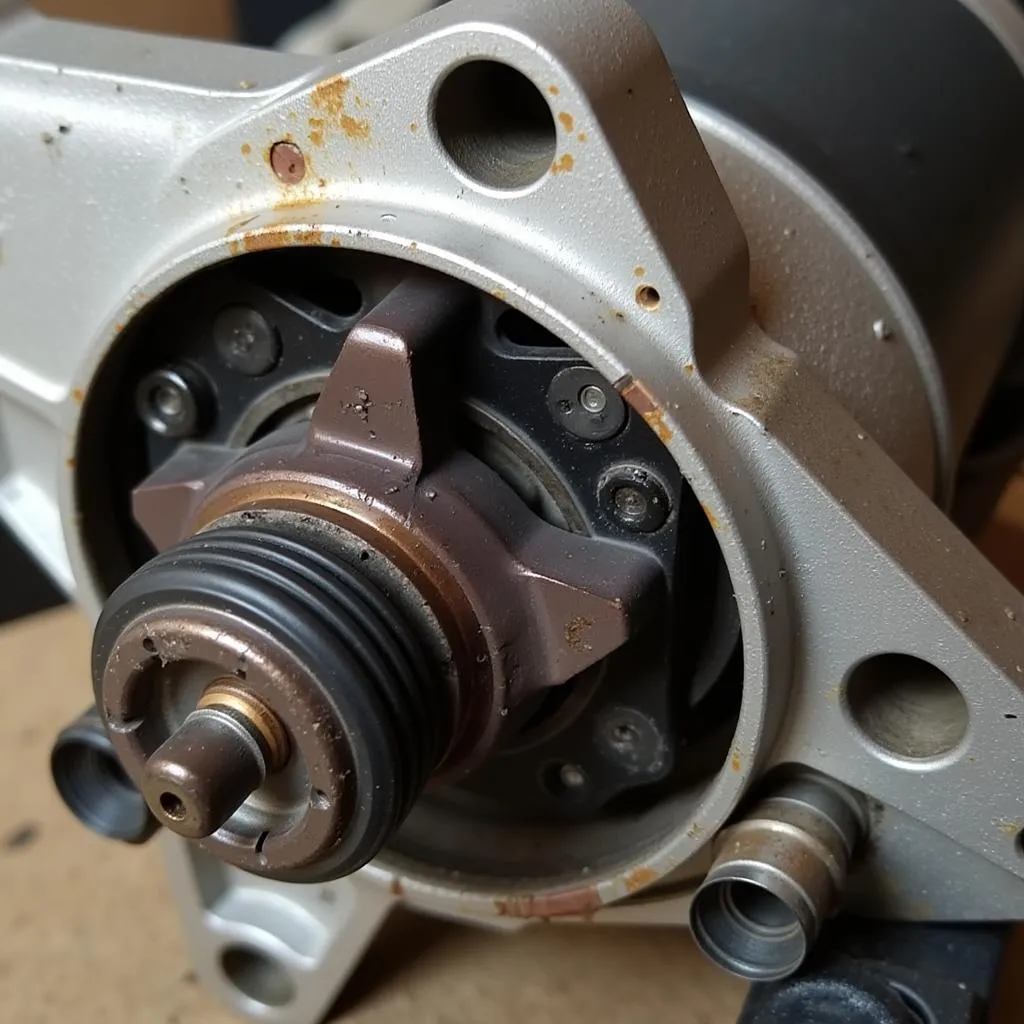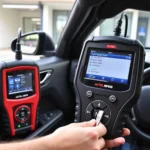Your car’s lights come on, but when you turn the key, nothing happens. No cranking, no clicking, just silence. It’s frustrating, right? This situation, commonly known as “lights turn on but no crank,” is a common car problem with a variety of potential causes.
This comprehensive guide will delve into the possible reasons why your car lights work but the engine won’t crank. We’ll explore the most common culprits, ranging from simple fixes to more complex issues that may require professional help.
Understanding the Problem: When Your Car Won’t Crank
Before we dive into the specifics, let’s first understand what happens when you turn the ignition key and why your car might refuse to cooperate. When you turn the key to the “start” position, you’re essentially completing a circuit that sends power from the battery to the starter motor. This powerful motor then cranks the engine, initiating the combustion process.
If your car lights turn on, it usually indicates that your battery has enough power. This means the problem likely lies somewhere between the battery and the starter motor, disrupting the flow of power needed for cranking.
Common Causes of “Lights Turn On But No Crank”
There are several reasons why your car lights might work but the engine won’t crank. Here are some of the most common culprits:
1. Faulty Starter Motor
The starter motor is a prime suspect when you experience a no-crank situation.
A failing starter motor can exhibit various symptoms, including a clicking sound when you turn the key, intermittent starting issues, or complete silence. If your starter motor is the problem, you’ll likely need a replacement.
2. Dead Battery
While your car lights might turn on, your battery might not have enough juice to power the starter motor.
This scenario is more likely if your lights seem dim or if you’ve recently experienced a jump-start. A simple battery test can confirm whether this is the issue.
3. Ignition Switch Problems
The ignition switch is responsible for sending the electrical signal to engage the starter motor.
Over time, the ignition switch can wear out or malfunction, preventing the signal from reaching the starter. A faulty ignition switch might require replacement.
4. Bad Starter Solenoid
The starter solenoid acts as a relay between the battery and the starter motor.
When you turn the key, the solenoid receives a small electrical signal from the ignition switch, which then triggers a larger electrical current to flow from the battery to the starter motor. A faulty solenoid won’t be able to effectively relay this signal, resulting in a no-crank situation.
5. Faulty Neutral Safety Switch
The neutral safety switch (or clutch switch in manual transmission vehicles) is a safety mechanism that prevents the engine from cranking unless the transmission is in “Park” or “Neutral.”
If this switch malfunctions, it can prevent the starter from engaging, even if the transmission is in the correct position.
6. Wiring Issues
Corrosion, loose connections, or damaged wiring in the starting circuit can interrupt the flow of power from the battery to the starter motor.
This can manifest as a no-crank condition, even if the battery and starter motor are in good working order.
7. Steering Column Lock Malfunction
Many modern vehicles feature a steering column lock that engages when the key is removed, acting as an anti-theft measure.
Sometimes, this lock can malfunction, preventing the key from turning fully or interfering with the ignition switch, leading to a no-crank situation.
Troubleshooting “Lights Turn On But No Crank”
Troubleshooting a no-crank issue can seem daunting, but it often involves a systematic approach to identify the root cause.
Here’s a simplified guide to help you:
- Check the Battery: Start by ensuring your battery has enough charge. Look for signs of a weak battery, such as dim lights or slow cranking. If your battery is completely dead, you’ll need to jump-start your car.
- Inspect the Starter Motor: Listen for any clicking sounds when you turn the key. If you hear a single click or multiple clicks, it could indicate a problem with the starter motor or solenoid.
- Examine the Ignition Switch: Jiggle the steering wheel while turning the key to see if it starts. If the engine cranks in a specific steering wheel position, it might point to a faulty ignition switch or a problematic steering column lock.
- Check the Neutral Safety Switch: Make sure your gear shifter is fully in “Park” or “Neutral” and try starting again. If you suspect a problem with the neutral safety switch, it’s best to consult a mechanic.
- Inspect Wiring and Connections: Visually inspect the wiring and connections in the starting circuit, looking for any signs of damage, corrosion, or loose connections.
When to Consult a Mechanic
While some no-crank issues can be resolved with simple DIY fixes, more complex problems often require professional attention.
If you’ve exhausted basic troubleshooting steps and haven’t identified the cause, it’s best to consult a qualified mechanic.
DiagXcar: Your Partner in Automotive Diagnostics
Dealing with car troubles can be stressful and time-consuming. DiagXcar understands the importance of accurate and efficient diagnostics.
We provide the tools and resources you need to tackle automotive challenges with confidence. Whether you’re a seasoned mechanic or a car enthusiast, DiagXcar empowers you with the knowledge and equipment to keep your vehicle running smoothly.
Conclusion
Experiencing a “lights turn on but no crank” situation can be perplexing, but understanding the common causes and employing a systematic troubleshooting approach can help pinpoint the issue.
Remember, while some fixes might be within the realm of DIY, more complex problems often necessitate the expertise of a qualified mechanic.
FAQs
-
Can a bad alternator cause a no-crank condition?
- While a bad alternator can eventually drain your battery, it won’t directly prevent the engine from cranking. A no-crank situation is more likely related to the starter motor, ignition switch, or battery itself.
-
My car starts intermittently. What could be wrong?
- Intermittent starting problems can be particularly frustrating to diagnose. Potential culprits include a failing starter motor, a loose connection in the starting circuit, or a faulty ignition switch.
-
How often should I replace my starter motor?
- Starter motors typically last for several years, but their lifespan can vary depending on factors like usage and driving conditions. If you experience persistent starting issues, it’s best to have your starter motor inspected.
Need Help? Contact Us!
If you need assistance diagnosing or resolving a “lights turn on but no crank” issue or any other car problem, don’t hesitate to contact our team at DiagXcar. We are available 24/7 via WhatsApp: +1(641)206-8880, Email: [email protected], or visit us at 276 Reock St, City of Orange, NJ 07050, United States.
Let us help you get back on the road quickly and safely!



